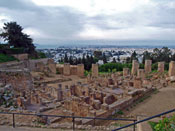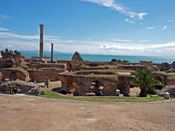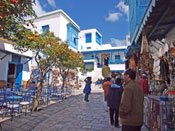FRANKFURT | CASABLANCA | ROAD TO FEZ | FEZ | ROAD TO ERFOUD | ONWARD TO OUARZAZATE | ROAD TO MARRAKECH | MARRAKECH | TUNISIA | CARTHAGE | DOUGGA/BULLA REGIA | DUBAI | AL MAHA | OMAN | SALALAH |
TUNISIA Day 2: CARTHAGEThe day started with a walk on the beach in front of our room: the southern Mediterranean Sea. While not as impressive as either the Atlantic or Pacific, it is peaceful in its own way. But COLD. The walk was short, but long enough to pick up some shells which Carol really liked. Our touring day began with a visit to the ancient city of Carthage, in particular an area called the Holy Hill. It is on a promontory overlooking the sea. For those of us who translated the Aneid or read Roman history or stories, Carthage occupies a special place. Abdi, our guide, loves history and can talk at length about the history of Carthage as well as of Tunis in general. We were reminded about the Roman/Phoenician wars (Punic Wars 1-3). When the Romans finally defeated the Phoenicians, they virtually leveled most of Carthage which, at the beginning of the Punic Wars, had a population (a half million) second only to Rome (a million). Rome built on top of old Phoenician Carthage, and what we saw (picture to the left) was a mix of original Phoenician with an overlay of Roman. The site is quite beautiful. Our touring day began with a visit to the ancient city of Carthage, in particular an area called the Holy Hill. It is on a promontory overlooking the sea. For those of us who translated the Aneid or read Roman history or stories, Carthage occupies a special place. Abdi, our guide, loves history and can talk at length about the history of Carthage as well as of Tunis in general. We were reminded about the Roman/Phoenician wars (Punic Wars 1-3). When the Romans finally defeated the Phoenicians, they virtually leveled most of Carthage which, at the beginning of the Punic Wars, had a population (a half million) second only to Rome (a million). Rome built on top of old Phoenician Carthage, and what we saw (picture to the left) was a mix of original Phoenician with an overlay of Roman. The site is quite beautiful.
The next stop was the Roman bath of Carthage, an  immense place right on the edge of the sea. I had not realized that the baths were really an upper class social club, with drinking, sports, shopping and visiting - in addition to baths. As Abdi said, the Romans invented boredom (they became so well off, with servants doing everything, that they had to create things to do.The elaborate bath rituals were one such entertainment). Eventually others did to Rome what Rome did to the Carthaginians: these extraordinary baths, which were built to last forever, had their marble and limestone stripped away by, among others, Byzantines, Islamic invaders, and Crusaders. They used Carthage as a building supply depot, taking those materials to build (for example) portions of Tunis (about 12 miles away) as well as to build portions of the cathedral at Pisa, Italy. immense place right on the edge of the sea. I had not realized that the baths were really an upper class social club, with drinking, sports, shopping and visiting - in addition to baths. As Abdi said, the Romans invented boredom (they became so well off, with servants doing everything, that they had to create things to do.The elaborate bath rituals were one such entertainment). Eventually others did to Rome what Rome did to the Carthaginians: these extraordinary baths, which were built to last forever, had their marble and limestone stripped away by, among others, Byzantines, Islamic invaders, and Crusaders. They used Carthage as a building supply depot, taking those materials to build (for example) portions of Tunis (about 12 miles away) as well as to build portions of the cathedral at Pisa, Italy.
We then went to see a couple of early Roman villas that were beautiful and quite large. On our way in to the villa area, Carol stopped to shoot a picture of a private home. In one of those impossible coincidences, a man and woman walking up the street said "You're taking a picture of our house" as they opened the gate. Carol said "I'm taking this to show our friends in San Diego, where we live." The woman then said, "Oh, we're going to San Diego for a wedding on the 22nd." What a small world. Speaking of small world, both Tunis and Morocco are full of cacti (the nopal and the maguey). We wondered why. Abdi told us that the Spaniards, who were also present in North Africa for centuries, brought them to the southern Mediterranean from the Americas.  We then went to visit a sixteenth century hill town called Sidi Bousaid, now a World Heritage site. Since the 16th century, and now by mandate, every house has to be white with blue window/door accents. There was one huge house in the center of this area that defied the rule. It was an adobe color. Abdi said that the family in that house has been defying the color edict since the 19th century. Is this a family with an agreed mission or what. We then went to visit a sixteenth century hill town called Sidi Bousaid, now a World Heritage site. Since the 16th century, and now by mandate, every house has to be white with blue window/door accents. There was one huge house in the center of this area that defied the rule. It was an adobe color. Abdi said that the family in that house has been defying the color edict since the 19th century. Is this a family with an agreed mission or what.
To conclude the day, Carol fell in love with a bracelet in the medina when we visited it yesterday. We returned to purchase it. However, to get in the mood to bargain and to make sure we understood the real value of the bracelet, we shopped EVERY jewelry store in the gold center --- and she fell out of love with the original bracelet and in love with another one. The little shop didn't take VISA and Carol only had limited American money (having decided to leave money, passports, etc. in the safe in the room) plus some Tunisian money. She convinced the shopkeeper to take all of the money she had (and two chocolate bars) as a fair price for the bracelet. Happily, it worked. |
|
| TURKEY AND GREECE | CIRCLE THE ARCTIC |